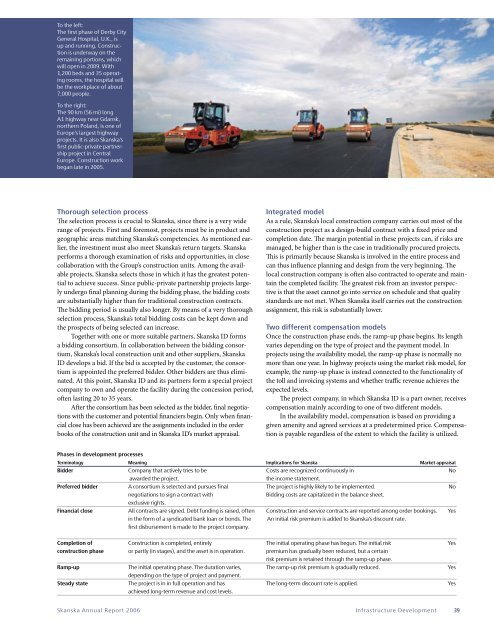ANNUAL REPORT 2006 - Skanska
ANNUAL REPORT 2006 - Skanska
ANNUAL REPORT 2006 - Skanska
Create successful ePaper yourself
Turn your PDF publications into a flip-book with our unique Google optimized e-Paper software.
To the left:<br />
The first phase of Derby City<br />
General Hospital, U.K., is<br />
up and running. Construction<br />
is underway on the<br />
remaining portions, which<br />
will open in 2009. With<br />
1,200 beds and 35 operating<br />
rooms, the hospital will<br />
be the workplace of about<br />
7,000 people.<br />
To the right:<br />
The 90 km (56 mi) long<br />
A1 highway near Gdansk,<br />
northern Poland, is one of<br />
Europe’s largest highway<br />
projects. It is also <strong>Skanska</strong>’s<br />
first public-private partnership<br />
project in Central<br />
Europe. Construction work<br />
began late in 2005.<br />
Thorough selection process<br />
The selection process is crucial to <strong>Skanska</strong>, since there is a very wide<br />
range of projects. First and foremost, projects must be in product and<br />
geographic areas matching <strong>Skanska</strong>’s competencies. As mentioned earlier,<br />
the investment must also meet <strong>Skanska</strong>’s return targets. <strong>Skanska</strong><br />
performs a thorough examination of risks and opportunities, in close<br />
collaboration with the Group’s construction units. Among the available<br />
projects, <strong>Skanska</strong> selects those in which it has the greatest potential<br />
to achieve success. Since public-private partnership projects largely<br />
undergo final planning during the bidding phase, the bidding costs<br />
are substantially higher than for traditional construction contracts.<br />
The bidding period is usually also longer. By means of a very thorough<br />
selection process, <strong>Skanska</strong>’s total bidding costs can be kept down and<br />
the prospects of being selected can increase.<br />
Together with one or more suitable partners, <strong>Skanska</strong> ID forms<br />
a bidding consortium. In collaboration between the bidding consortium,<br />
<strong>Skanska</strong>’s local construction unit and other suppliers, <strong>Skanska</strong><br />
ID develops a bid. If the bid is accepted by the customer, the consortium<br />
is appointed the preferred bidder. Other bidders are thus eliminated.<br />
At this point, <strong>Skanska</strong> ID and its partners form a special project<br />
company to own and operate the facility during the concession period,<br />
often lasting 20 to 35 years.<br />
After the consortium has been selected as the bidder, final negotiations<br />
with the customer and potential financiers begin. Only when financial<br />
close has been achieved are the assignments included in the order<br />
books of the construction unit and in <strong>Skanska</strong> ID’s market appraisal.<br />
Integrated model<br />
As a rule, <strong>Skanska</strong>’s local construction company carries out most of the<br />
construction project as a design-build contract with a fixed price and<br />
completion date. The margin potential in these projects can, if risks are<br />
managed, be higher than is the case in traditionally procured projects.<br />
This is primarily because <strong>Skanska</strong> is involved in the entire process and<br />
can thus influence planning and design from the very beginning. The<br />
local construction company is often also contracted to operate and maintain<br />
the completed facility. The greatest risk from an investor perspective<br />
is that the asset cannot go into service on schedule and that quality<br />
standards are not met. When <strong>Skanska</strong> itself carries out the construction<br />
assignment, this risk is substantially lower.<br />
Two different compensation models<br />
Once the construction phase ends, the ramp-up phase begins. Its length<br />
varies depending on the type of project and the payment model. In<br />
projects using the availability model, the ramp-up phase is normally no<br />
more than one year. In highway projects using the market risk model, for<br />
example, the ramp-up phase is instead connected to the functionality of<br />
the toll and invoicing systems and whether traffic revenue achieves the<br />
expected levels.<br />
The project company, in which <strong>Skanska</strong> ID is a part owner, receives<br />
compensation mainly according to one of two different models.<br />
In the availability model, compensation is based on providing a<br />
given amenity and agreed services at a predetermined price. Compensation<br />
is payable regardless of the extent to which the facility is utilized.<br />
Phases in development processes<br />
Terminology Meaning Implications for <strong>Skanska</strong> Market appraisal<br />
Bidder Company that actively tries to be Costs are recognized continuously in No<br />
awarded the project.<br />
the income statement.<br />
Preferred bidder A consortium is selected and pursues final The project is highly likely to be implemented. No<br />
negotiations to sign a contract with<br />
Bidding costs are capitalized in the balance sheet.<br />
exclusive rights.<br />
Financial close All contracts are signed. Debt funding is raised, often Construction and service contracts are reported among order bookings. Yes<br />
in the form of a syndicated bank loan or bonds. The An initial risk premium is added to <strong>Skanska</strong>’s discount rate.<br />
first disbursement is made to the project company.<br />
Completion of Construction is completed, entirely The initial operating phase has begun. The initial risk Yes<br />
construction phase or partly (in stages), and the asset is in operation. premium has gradually been reduced, but a certain<br />
risk premium is retained through the ramp-up phase.<br />
Ramp-up The initial operating phase. The duration varies, The ramp-up risk premium is gradually reduced. Yes<br />
depending on the type of project and payment.<br />
Steady state The project is in in full operation and has The long-term discount rate is applied. Yes<br />
achieved long-term revenue and cost levels.<br />
<strong>Skanska</strong> Annual Report <strong>2006</strong> Infrastructure Development 39

















